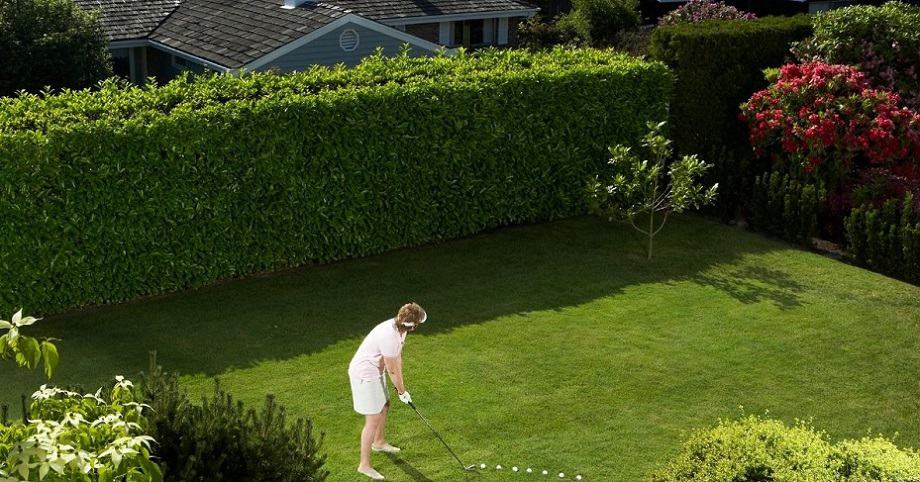As an Amazon Associate, I earn from qualifying purchases. There is no extra cost to you. Thank you if you use our links; we appreciate it! Learn More.

If you have a spacious backyard, you could leave it for the dogs to romp through or plant more daylilies, but if you want to improve your golf game—and why wouldn’t you—you may as well transform your backyard into a picturesque putting green complete with natural grass. Although there are companies specializing in golf course and putting green installations, you can take the do-it-yourself approach to save money. Creating this feature is highly doable if you have maintained a lawn before and have some moderate landscaping skills.
Here, we’ll explore the benefits of backyard golfing and how to create your perfect DIY putting green.
Health Benefits of Backyard Golfing
The game of golf offers players both physical and mental health benefits. The fact that many people enjoy the game attests to its positive impact on mental health and stress relief. The moderate exercise associated with golf can actually provide relief from symptoms of anxiety and depression. After a stressful day at work, you can come home and head to your backyard to unwind while practicing on your putting green.
Golf can also offer physical health benefits. For instance, you can actually cut your risk of having a heart attack by walking at least 2.5 hours per week. Yes! Simply walking around your yard counts toward these hours. Exercising in the form of golf helps you burn calories and supports optimum bone health. Getting out in the sunshine and fresh air is something you can do routinely—and conveniently—when you have a golf course in your own backyard.
Turn Your Backyard into a Golf Course Putting Green

If you have the space (ideally, you’ll need about 1,000 square feet), you can create a luxurious putting green even on a modest budget. Constructing your putting green yourself saves you the cost of labor and allows you to customize your site with greater ease. Use the following steps as a guide for installing your backyard golf course putting green.
Make a Plan
Before you start digging into your yard, create a detailed plan for your project. Drawing your putting green or completing an online blueprint allows you to map out each aspect of your course, such as its shape, where you’ll place the cups, surrounding landscaping, special features, and any other details that come to mind. You should include a list of tools and materials you’ll need as well as steps that outline what tasks to perform first.
Select a Site
Walk around your backyard so that you can determine a site for your putting green that’s level. Choosing an area that’s already level means less work for you. Once you have an idea of your course’s placement, use tape or spray paint to create its shape. Having an outlined area will make it easier for you to maintain the course’s shape as you work.
Dig
Next, prepare to dig up your earth to remove stones, surface tree roots, and turf. Fortunately, you don’t need to dig too deep in most cases. Try to remove about 10 inches of dirt. The depth can be as shallow as a cake pan. Once you remove the dirt, you may want to spray the area with weed killer. You can also lay down some landscape fabric to help prevent future weed growth.
Prepare Your Base and Add Contour
Adding contour is easy. You’ll want to create your base using crushed gravel, which is ideal for good drainage. To create more contour, you’ll simply use more base in those areas. The contour will lend a more dynamic appeal to your backyard course. Be sure, however, that you don’t create slopes that lead inward to the middle of your course, or rain is apt to pool there.
Install Drainage and Cups
As you prepare your base, you’ll also want to add some drainage pipes. Opt for four-inch perforated drainage pipes and try to arrange them in a herringbone pattern. First, dig small trenches, then lay and connect your pipes, and then cover them with pea gravel. Afterward, you can complete your base and install your cups.
Build golf hole according to this guide.
Sand
Sand allows you to finish your base and is the last step before laying sod or planting seed. However, don’t choose just any sand. Golf course sand is recommended because it drains. A well-draining golf course allows you to maintain the health and beauty of your turf more easily.
If you wanna add a sand trap in your backyard, then follow this guide.
Seed It or Sod It
You’ll need to decide if you will seed or lay sod for your golf course putting green. Golf experts say that seed is better in the long run, but it’s easier to lay down sod. You’ll want to choose a natural grass variety that is apt to thrive in your climate. You may want to contact a professional landscaper to discuss your project and what type of grass strain to choose.
Plan to set aside time for maintaining your turf, especially just after you install it. Your green will require regular watering and fertilization to ensure its optimum health. Generally, it takes about two months before you can enjoy putting on your green—and at least another month more before it will appear finished.
Once your putting green is complete and you’re simply waiting for the grass to grow, you may want to do some additional landscaping around the course’s edges. You may also wish to install a border around your course to help prevent weeds or natural grass from spreading. You should also plan to invest in a greens mower to keep your course looking—and functioning—optimally once it’s ready to be maintained.
Your backyard putting green may very well become your favorite place to be. You can enjoy this feature daily or on the weekends. Plus, its beauty is sure to enhance the look of your property too.
Read More:
- Wanna build a mini golf course in your backyard?
- Practice golf in the winter
- Ways to Keep golf course in perfect condition
- Chipping drills for indoor practice
- Increase club head speed
Amazon and the Amazon logo are trademarks of Amazon.com, Inc, or its affiliates.
Daisy is the Founder and Editor in Chief of Golfs Hub. She is associated with Golf for more than 20 years. She got the inspiration from her father. She is a very private person & doesn't like to be photographed. She's worked in nearly every job in the golf industry from club fitting to instruction to writing and speaking. Now she is enjoying her retirement from day job... but not from Golf! Daisy lives in southeasternmost part of New York state with her family.





